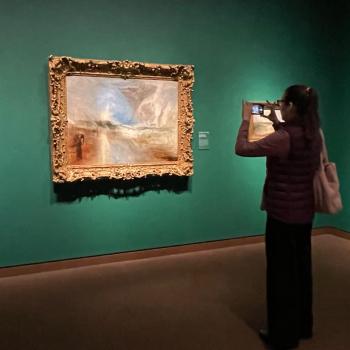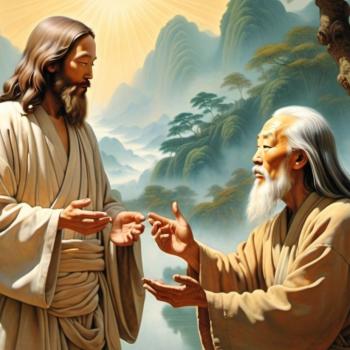She passes beneath the cliff top. Two men who had been crucified with Jesus still hang there, on wooden crosses where they will be devoured by birds and dogs. She goes to a far corner of the quarry to a garden, where the cliff side has row upon row of handhewn caves, tombs for the dead.
All the empty tomb means for Mary is that Jesus' body has been stolen. She assumes the worst, not the best. Who would assume something that is too good to be true? She retraces her steps at a run and wakes Simon Peter and the Beloved Disciple. They each clear the sleep from the corners of their eyes, throw on jeans and a sweatshirt, stuff their feet into their sneakers and come running.
1) First response to this Easter for which no one was prepared. The Beloved Disciple outran Peter. Who was he? We don't know his name. We do know he was present in key scenes from the Gospel of John. He was present at the Last Supper and at the foot of the cross. He followed Jesus into the High Priest's house, and he followed the resurrected Jesus along the shore of the Sea of Tiberius (Jn. 21:20).
What was this Beloved Disciple? Scholars debate. Maybe he was John Mark. Maybe Lazarus. Maybe Thomas.
Whoever he was, John portrays him as "one who had become very sensitive to Jesus through love" (Raymond Brown, 1005, volume 29, Anchor Bible Volume on John).
Here, on Easter morning, the Beloved Disciple is first to believe that Jesus is risen. He doesn't go in until Peter does, but after Peter goes in, the Beloved Disciple goes in the tomb. John tells us that "He saw and believed" (Jn. 20:8). But then—he goes on home, thinking, perhaps, "This changes everything, but I'm not sure how. Let me just me mull this over a while before I tell anyone else about it."
Why this response? Was he overwhelmed, feeling like this was news too good to be true?
We are not told. But if his response is your response, maybe you can answer for yourself.
2) Second response to unexpected Easter. Then there is Peter, the brash big talker and then, in the pinch, the threefold betrayer. Bold as always, he doesn't hesitate at the entrance to the tomb. He goes right in, and then he goes right home. John tells us that he saw the linen wrappings and the cloth that had been on Jesus' head rolled up in a place by itself. John doesn't tell us his inner response. But Luke does. Luke tells us that "He was amazed at what had happened" (Lk. 24:12). He ran right in and then he ran right home.
Why this response? Was he numb with guilt over having betrayed Jesus? Did he feel unworthy of such good news? We are not told. But if his response is your response, maybe you can answer for yourself.
3) Third response to unexpected Easter joy. The disciples go on home, clearing center stage for Mary. On her second trip of the morning, she looks inside the empty tomb and sees something neither Peter nor the other disciple saw—two angels in white sitting at either end of where the body had been.
Usually angels make weighty pronouncements like they do in Matthew and Luke. "Do not be afraid. He is not here. He has been raised as he said. Come, see the place where he lay, then go quickly and tell the disciples, 'He has been raised from the dead and is going ahead of you to Galilee, there you will see him'" (Mt. 28:5-7).
If an angel is going to scare me out of my wits, at least bring an evite and a Garmin. Give me information about where to meet Jesus and directions to the meeting place. But here they just ask a really obvious question. "Woman, why are you weeping?"
I wonder if Mary felt a momentary flash of irritation? I wonder if she felt like saying, "Well, angels, why do you think I'm weeping? I'm weeping over the crucifixion of my most cherished hope in life. My eyes are wet with the tears of the bereaved. Why do you think I'm weeping?"
I have a theory that the angels, while she's explaining why she's weeping are pointing behind her as if to say "turn around, turn around." I think they have come to give directions, after all. To a Resurrected Lord who, from now on, is always standing right behind her, whose presence doesn't depend on whether she feels him there or not, whether she's ready or not.
Because, according to John's story, Christ rises in the dark. Christ rises for everyone. Easter is precisely for those who are not ready for it.
Easter is for Peter, too absorbed in the pain of his past to take it in. Easter is for the Beloved Disciple, who believes in Jesus' resurrection but needs time to process what difference it makes. Easter is for Mary, weeping over her loss while her Lord stands right behind her.
According to the story, Easter is for each of us who is all of them.
I know that tomorrow they'll put the marshmallow chicks on the bargain table at the grocery store, and take the lavender and yellow crepe paper off the shelves to make room for Mother's Day coffee mugs and gifts for the graduates. Like an impatient waiter whisking our plate away before we're through eating, our retail culture doesn't give us much time to savor Easter. But it can't prevent our liturgical lingering. It can't take away the fifty days of the Easter Season until Pentecost that lie ahead. Days to pray and to ponder. Days to rejoice in the Lord who stands behind us healing our past, who stands before us framing our future with joy.





